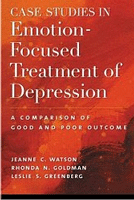Case Studies in Emotion-Focused Treatment of Depression: A Comparison of Good and Poor Outcome

Case Studies in Emotion-Focused Treatment of Depression: A Comparison of Good and Poor Outcome
By Jeanne C. Watson, Rhonda N. Goldman, and Leslie S. Greenberg
American Psychological Association
Washington, D.C., 2007
Depression treatment method examined in book
Reviewed By James K. Luiselli, Ed.D., ABPP, BCBA
Depression is a frequent clinical problem seen by mental health professionals. This book has to do with a specific therapeutic approach called Emotion-Focused Treatment (EFT). The theory behind EFT is that “depression arises from problems in affect regulation and results from maladaptive, blocked and unprocessed emotional experience.” Accordingly, the purpose of the book is to describe the application and outcome of EFT through detailed presentation and analysis of case studies.
The introductory chapter outlines several guiding principles of EFT. The approach emphasizes “establishing an empathic healing relationship” with clients, generated through “empathy, acceptance, and genuineness.” These and many other constructs are described but I struggled to understand how they differ from most conventional psychotherapies.
Another component of EFT is having clients complete specific in-session tasks “to resolve particular cognitive-affective problems.” The “empty chair” task, for example, requires one to imagine a significant other sitting in a chair as a way to evoke emotions and perceptions. Another EFT task, “systematic evocative unfolding,” has the objective of triggering memories and reactions that can be pursued by client and therapist. The authors stress that these and other tasks are integral to the “process-experiential” foundation of EFT.
There are six case studies in the book and each one is depicted similarly: a client is introduced, the presenting problems are defined and a formulation is offered. Then, various EFT procedures that were implemented with the client are explained. The cases feature extensive client-therapist dialogue to illustrate therapeutic process and problem solving. As well, the authors comment about why therapy was successful with some but not all of the clients.
EFT seems to borrow from other psychotherapy techniques for depression including cognitive-behavioral therapy (CBT), acceptance and commitment therapy (ACT), and functional analytic psychotherapy (FAP). The sheer number of techniques that comprise EFT is impressive but unfortunately, I found it difficult to see how they fit within a cohesive conceptual model. Also, the research on EFT as an effective treatment of depression has been conducted solely by the authors – more elaborate hypothesis testing and controlled replication by other investigators is needed before EFT can be advanced as an evidence-based treatment.
The largest audience for this book likely is professionals who specialize in treating depression. For students, one benefit of reading the book would be gaining insight into the complex world of conducting psychotherapy with seriously depressed people. Readers also may want to refer to the authors’ earlier treatment manual, “Emotion-Focused Therapy for Depression,” to learn more about the theory, empirical base, and practical application of EFT.
James K. Luiselli, Ed.D., ABPP, BCBA, is senior vice president, applied research, clinical training and peer review at the May Institute in Norwood, Mass.
Learn more about the book: Buy It Now!
